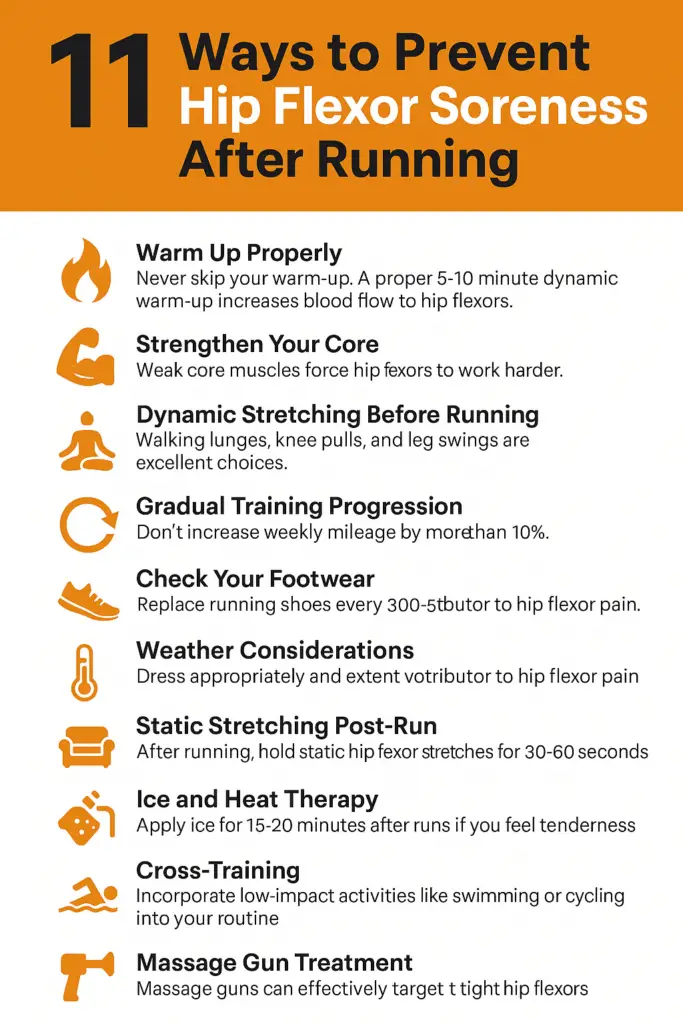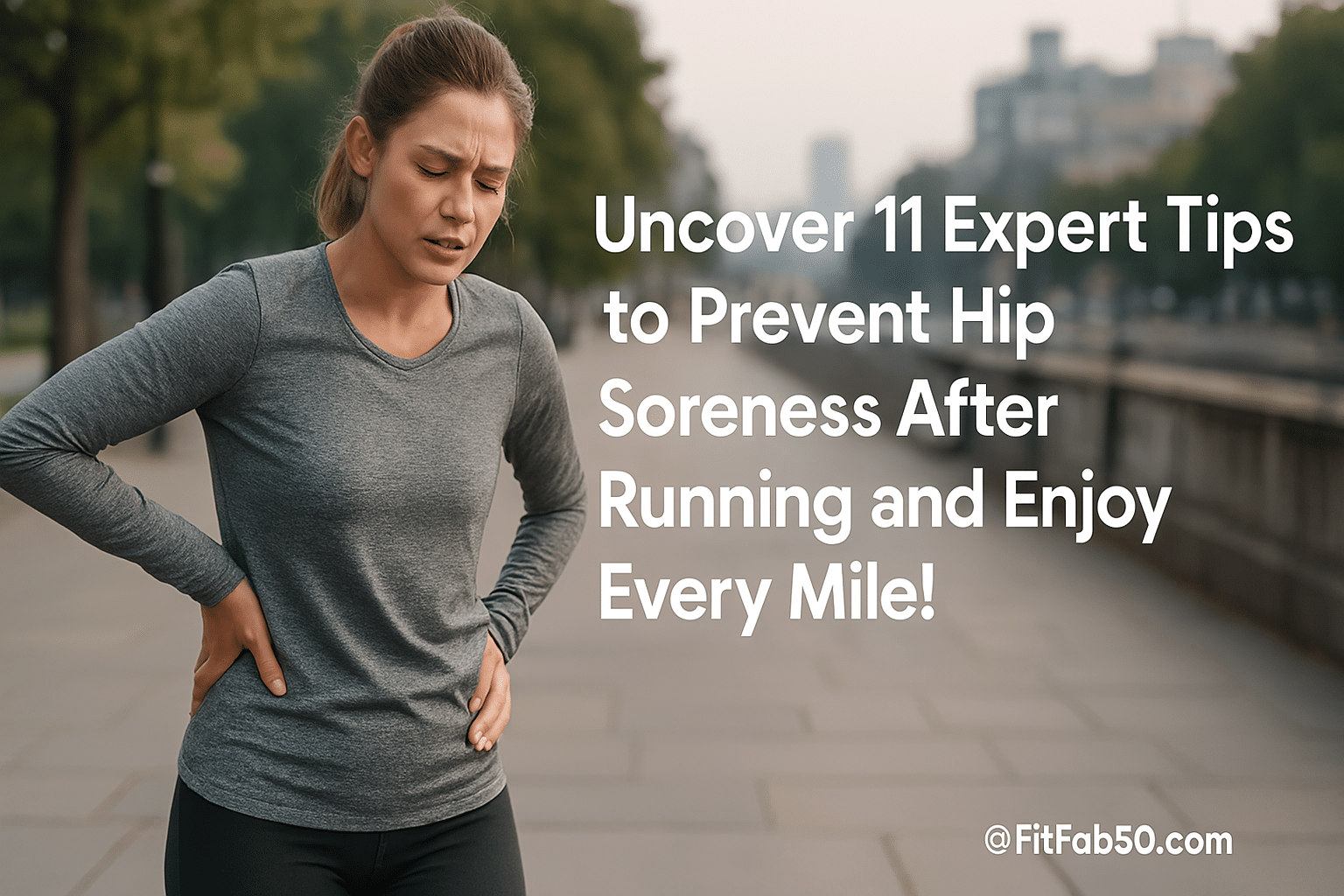As a runner over 50, I know that hip flexor pain can stop you in your tracks. These crucial muscles help lift your knees and move your legs forward with each stride. When they get angry, your running routine suffers.
I’ve compiled these 11 proven ways to prevent hip soreness after running based on my experience and research. Let’s dive into what causes this common problem and how you can avoid it.
Table of Contents
What Causes Hip Flexor Soreness?
Hip flexor pain typically happens when these muscles become overworked, tight, or inflamed. The main culprits include:
- Overtraining without proper recovery
- Running on hills or uneven surfaces
- Poor running form
- Weak core muscles
- Inadequate warm-up

Who’s Most Likely to Suffer?
Not all runners experience hip flexor pain equally:
- Age factor: Runners over 40 experience more hip flexor issues as muscle elasticity decreases with age
- Gender differences: Women are slightly more prone due to wider hip structure and different Q-angles
- Running experience: Beginners often suffer more as their bodies adapt to new movement patterns
Outside Hip Pain vs. Front Hip Pain
Many runners confuse hip flexor pain with other hip issues. Let me clarify the difference:
Outside hip pain after running typically involves the IT band or gluteus medius. This feels like a sharp pain on the outer part of your hip.
Front hip pain after running usually points to true hip flexor issues, particularly in the iliopsoas muscles. You’ll feel this in the crease where your leg meets your torso.
Knowing which type you have helps target the right treatment approach.
Key Tips to Prevent Hip Soreness After Running
11 Ways to Prevent Hip Flexor Soreness After Running
1. Warm Up Properly
Never skip your warm-up. A proper 5-10 minute dynamic warm-up increases blood flow to hip flexors.
Try leg swings, high knees, and gentle walking lunges before hitting your stride.
2. Strengthen Your Core
Weak core muscles force hip flexors to work harder. Add planks, bridges, and bird-dogs to your routine 2-3 times weekly.
A strong core helps maintain proper running form and reduces hip flexor strain.
3. Dynamic Stretching Before Running
Dynamic stretching before running helps prepare hip flexors for action. Walking lunges, knee pulls, and leg swings are excellent choices.
Avoid static stretching before runs as it can temporarily weaken muscles.
4. Gradual Training Progression
Don’t increase weekly mileage by more than 10%. Sudden increases in training volume commonly trigger hip flexor issues.
Your body needs time to adapt to increased demands.
5. Check Your Footwear
Worn-out shoes affect your gait and can strain hip flexors. Replace running shoes every 300-500 miles.
Consider getting professionally fitted if you experience recurring issues.
6. Improve Running Form
Poor running form is a major contributor to hip flexor pain. Focus on:
- Mid-foot striking
- Maintaining tall posture
- Avoiding overstriding
- Keeping a slight forward lean
Consider a professional running analysis if problems persist.
7. Weather Considerations
Cold weather tightens muscles, including hip flexors. Dress appropriately and extend your warm-up in cold conditions.
Hot weather requires proper hydration to prevent muscle cramping.
8. Static Stretching Post-Run
After running, hold static hip flexor stretches for 30-60 seconds. The half-kneeling hip flexor stretch and reclined pigeon pose are particularly effective.
Consistent post-run stretching maintains hip flexor length and flexibility.
9. Ice and Heat Therapy
Apply ice for 15-20 minutes after runs if you feel tenderness. Use heat before running to increase blood flow to tight hip flexors.
Alternating between ice and heat can accelerate recovery for chronic tightness.
10. Cross-Training
Incorporate low-impact activities like swimming, cycling, or elliptical training into your routine.
Cross-training reduces repetitive stress on hip flexors while maintaining cardiovascular fitness.
11. Massage Gun Treatment
Massage guns can effectively target tight hip flexors. Use on a low setting for 1-2 minutes per area.
Start gently and increase intensity gradually. The quadriceps, TFL, and psoas areas benefit most from this treatment.
How to Get Rid of Hip Pain from Running
If you’re already experiencing hip pain, try these quick relief strategies:
- Rest: Take 1-3 days off from running depending on pain severity
- Compression: Use compression shorts to support the area
- Elevation: Elevate your legs when resting to reduce inflammation
- Anti-inflammatory measures: Consider OTC medications if approved by your doctor
- Foam rolling: Gently roll affected areas for 30-60 seconds
One-Sided Hip Flexor Pain: What It Means
Hip flexor pain running on one side often indicates muscle imbalance or running surface issues. Common causes include:
- Running on cambered roads (always facing traffic)
- Leg length discrepancies
- Strength imbalances between sides
- Previous injuries creating compensatory patterns
To address one-sided pain:
- Switch the side of the road you run on when safe
- Focus on strengthening the weaker side
- Check for footwear issues that might contribute to imbalance
When to Seek Help
If hip flexor pain persists despite these preventative measures, consult a physical therapist or sports medicine doctor. Chronic pain might indicate a more serious condition requiring professional intervention.
Signs you should see a professional include:
- Pain lasting more than two weeks despite rest
- Pain that worsens with specific movements
- Pain accompanied by clicking or popping
- Inability to bear weight without pain
- Pain that disrupts sleep
Final Thoughts
Hip flexor soreness doesn’t have to derail your running routine. By implementing these prevention strategies, you can keep these crucial muscles happy and healthy for the long run.
Remember that consistency is key. Incorporate these practices into your regular routine rather than only when pain strikes.
What hip flexor prevention strategies work best for you? I’d love to hear your experiences in the comments!
FAQ: Hip Pain Jogging Questions
Why do my hips hurt after running?
Your hips hurt after running typically because of muscle fatigue, tightness in the hip flexors, weak supporting muscles, or improper running form. Running creates repetitive impact forces that can stress these muscles, especially on hard surfaces or with poor biomechanics.
How long does hip flexor pain from running last?
Minor hip flexor soreness usually resolves within 3-7 days with proper rest and treatment. More severe strains can take 2-6 weeks to heal completely. Continuing to run through pain can extend recovery time significantly.
Should I run if my hip flexors are sore?
Light activity like walking can help with mild soreness, but running with moderate to severe hip flexor pain isn’t recommended. Listen to your body—sharp pain is a signal to rest. Consider cross-training activities that don’t aggravate the area until pain subsides.
Can hip flexor pain be prevented with specific running shoes?
While no shoe specifically prevents hip flexor pain, proper footwear that matches your gait pattern and provides appropriate support can help maintain proper alignment and reduce strain. Replace worn shoes regularly and consider professional fitting if you experience recurring issues.

Rick Huey is a fitness writer who has dedicated his life to living an active lifestyle. With more than 30 years of experience in the fitness industry, Rick is a respected contributor for FitFab50.com, where he shares his wealth of knowledge with a wide audience. His dedication to promoting the benefits of living an active lifestyle has inspired many people to pursue their own fitness journeys with enthusiasm and dedication.
